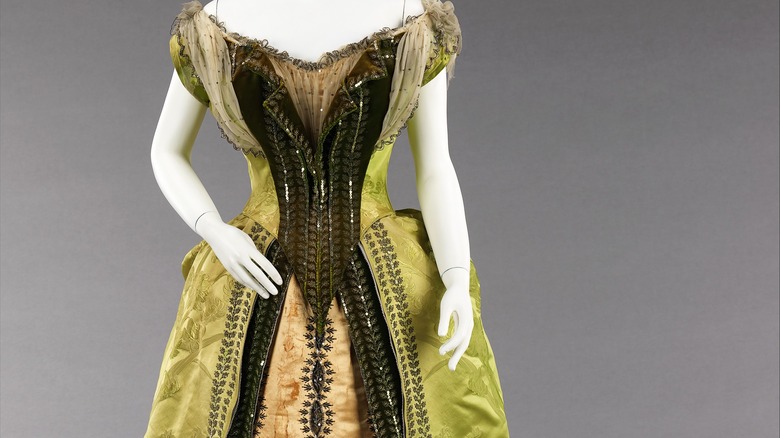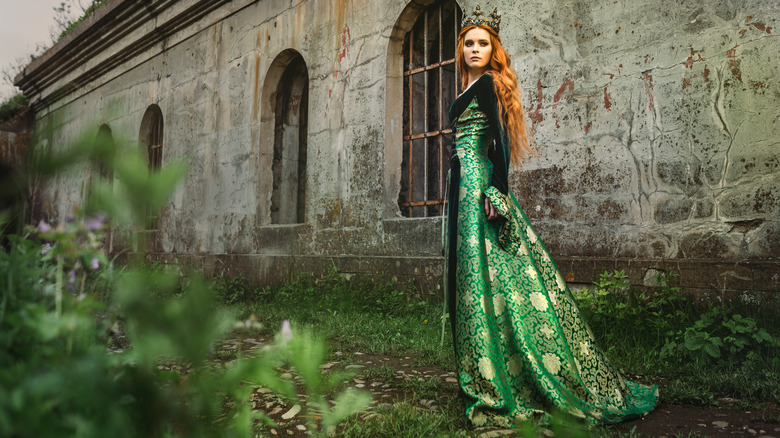How Green Victorian Dresses Killed Those Wearing Them
You might have heard the expression "knock 'em dead" related to fashion. Often, the meaning of this phrase is anything but literal, but there is one exception. Back in the old Victorian era, the green dress, as sold in a very specific jewel-toned shade, was killing it — literally.
According to Racked, fashion enthusiasts of the Victorian era were so bent on making an impression in the dim, gaslit rooms of their time that they went to all sorts of extremes. One of those extremes was arriving in dresses that were painted a deadly emerald green color. Not only were these frocks fully capable of killing the people who had them on, but they were so dangerous that they could take out an entire room.
According to Jezebel, the British Medical Journal described a woman wearing such a dress as "a killing creature. She actually carries in her skirts poison enough to slay the whole of the admirers she may meet with in half a dozen ballrooms." It's clear that these dresses were a devastating trend, but what exactly made them so toxic?
Green Victorian dresses killed those wearing them with arsenic-laced dye
The popularity of the emerald green British Victorian dress is proof of how much people are willing to risk in the name of fashion. Due to the fact these dresses were dyed with enough poisonous arsenic to kill 20 people, it's a wonder anyone would want to wear one at all (via Jezebel).
The deaths they caused were particularly gruesome. The body would first be ravaged by scabby ulcers. This initial reaction would be followed by the vomiting of blood and eventually fatal organ failure, breathing new meaning into the phrase "fashion victim." One ill-fated seamstress was exposed to so much of the arsenic that she claimed on her deathbed that all she could see was green — as if the world had taken on a spooky emerald hue (via Racked).
Given the heinous nature of these deaths, you might assume that fashionable socialites were unaware of the risks that wearing such garments carried. Quite the contrary. Medical professionals made every attempt to address the health crisis, to no avail. Apparently, when it comes to wearing muted tones in a social setting, these femme fatales would have preferred to drop dead.
The dye itself omitted an odor that reeked of dead rodents
Speaking of dropping dead, Racked goes on to explain that when this arsenic-laced dye made contact with certain household materials — such as wallpaper — it produced an unmistakable "mouse-like odor." It's difficult to imagine this fatal frock gaining any admirers whatsoever, with the stench of dead rodents wafting through the air at every turn.
This horrid smell makes sense, given the toxic ingredients of the dye. After all, arsenic was pretty much synonymous with rat poison in the Victorian era (via History of Yesterday). Interestingly enough, it seems only visitors from far-off lands — like the foreign dignitary who came to see Queen Victoria in Buckingham Palace — complained of the smell. It is possible that locals never noticed it because they had become accustomed to it. As time wore on, this toxic emerald hue was literally everywhere — on the walls and the floor, on the frocks and the gloves. Victorian Britain was basically bathing in toxicity as arsenic found its way into fashion, killing and maiming everyone in its path (via BuzzFeed).
Loose regulations allowed arsenic-laced green to thrive
While many blamed fatalities resulting from these green frocks on the fashionistas who wore them, the truth is that Victorian Britain was painted the shade of corporate greed. According to Jezebel, arsenic acid was only regulated when sold on an individual level. Indeed, acts like the Arsenic Act of 1868 failed to regulate the large-scale manufacturing of the toxic hue by major corporations that stood to gain massive profits from the poison. This is despite the fact that doctors and physicians began speaking out in the late 1850s, only to endure nearly 40 years of silence and death.
Over the decades, green fashion killed without bias or care, taking down socialites and factory workers, babes in cradles, and ladies in gas-lit rooms alike. It's important to note that factory workers bore the brunt end of the misery. Many of them were forced to die working with the dye, even when they were aware of the dangers.
It wasn't until 1895 that stricter regulations relegated arsenic-related death to a dark page in fashion history's past (via Racked). Even then, high levels of the toxic tint were found in fashionable packaging on things like shoe boxes and storage accessories. According to The New York Times, toxic substances and carcinogens are commonly found in green fashion to this very day. Some shades of green are not only harmful to the wearers but also to the environment itself.



